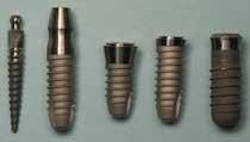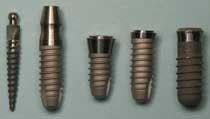How to profit from implants
Charles A. Vogel, DDS
The year is 2010. Dentistry in its evolutionary fashion has continued to change. Everything we do in dentistry in 2010 has an aesthetic basis.
It seems hard to believe that amalgam, which was used to save millions of teeth for over 100 years, is virtually nonexistent now. More aesthetic, far superior products have superceded it. Orthodontics and surgeries are still necessary. However, root canals are the biggest change in my practice. Rarely do I perform a root canal. If I do, it is only to salvage an existing prosthesis for a few more years. When treatment-planning for a new prosthesis where there is a questionable tooth, I merely remove it and replace it with a dental implant. Wow — how things have changed since 2003! How did my practice get here?
The '90s brought root-formed dental implants into the United States. Year by year, they gradually gained acceptability. Then, in 2000, they really took off in popularity! Dentists realized that dental implants were at least 95 percent predictable. We realized that implants had no accessory canals and didn't fracture or crack like roots. Economy of scale came into play — the more implants being performed, the less expensive the cost.
In fact, you now can do an implant and crown for not much more than the cost of performing a root canal, followed by a post and crown. The implant crown can be cemented temporarily without fear of leaking margins destroying the underlying structure. This is possible because there isn't anything underneath that can be destroyed. What might start out as a single-tooth implant can be converted to an overdenture attachment by using different types of attachments, as the patient's needs change.
When I started dentistry in Springfield, Mo., some 30+ years ago, we didn't have an endodontist. In fact, very little endodontic treatment was being performed. A few years later, an endodontist tried to make it on a part-time basis, but there was not enough business to keep him busy. Now, in 2010, four endodontists keep very busy. They are kept busy due to referrals from general dentists who prefer not to do some 20 to 40 percent of the root canal treatment their patients require.
The same trend will occur with dental implants. As the general dentists begin doing more implants, they will see more uses for them. Abraham Maslow once said, " If you give a man a hammer, he will go around looking for nails." I predict that if you give a general dentist implants as part of his diagnosis and treatment- planning, he will see many more ways to use them. With both root canals and implants, we are fooling Mother Nature. However, implants have fewer weaknesses and are more biocompatible and flexible in treatment-planning than a tooth on which a root canal has been performed. Once this modality enters your practice and becomes an accepted part of treatment, there will be no turning back.
As forward-thinking nuances such as preformed, immediate, lightly-loaded implant temporaries that meet the patient's aesthetic needs during healing become more available, the evolving implant field will develop more rapidly. In general dentistry, treatment-planning will undergo a revolution. No longer will teeth be salvaged with periodontal and endodontic complications. They will be sacrificed and immediately replaced with an implant, or bone-grafted with an implant to follow at a later date. Because of the information era that we live in, this evolution in dentistry will be faster than at any other time.
I hope this introduction will tantalize you enough to read on, so you and your patients can begin to profit from dental implants.
The time is now
General dentists had few opportunities in the early 1990s to learn how to surgically place dental implants. It was primarily an area reserved for oral surgeons and periodontists. As technology has evolved, implant placement has been greatly simplified. The time could not be better for general dentists to add implant surgery to their dental armamentarium.
Several universities and dental implant companies offer training courses on a regular basis. I began implant surgery training in the '90s, but had I just started my implant surgery journey, I would have begun with IMTEC Corporation's mini-implant system. It offers a straightforward approach to help a loose lower denture. I find the surgery to be simpler than most extractions, and the fact that a flap is not needed minimizes post-op healing. Utilizing local infiltration anesthetic, I can place four mini-implants in a one-hour appointment. After placing the mini implants, a protective treatment liner is fitted into the denture, covering the surgery areas for four-to-six weeks. At that time, the "minis" are loaded with an o-ring attachment that stabilizes the lower denture.
IMTEC's course was very complete. I would advise you to schedule at least two cases to perform immediately after you take the course. By doing this, not only are the skills fresh in your mind, but you can immediately begin recouping your training and start-up costs. At the end of the course I attended, I had an opportunity to purchase a small surgery kit and implants at a discount price. Mini-implants have definitely been a worthwhile investment for my patients and me.
Full-size dental implants require more training and skill. However, with careful selection, I have found them to be no more complex than partially erupted third- molar removal. Some will require a flap, others will not. Local anesthetic will be adequate, and post-op discomfort is less than with most third-molar extractions.
Hand-holding available
Implant companies are offering great incentives for general dentists to get more involved in their services. A new company in the United States, Thommen Medical, is high on my list for providing a lot of support, training, and hand-holding. They have a company representative on-site during your early surgeries. In the past, Straumann USA, a more-established company, also has been helpful. As a general dentist, I have found their prosthetic attachments to be most user-friendly, much like doing routine crown and bridge. In fact, all of Straumann's systems seem to be well-thought-out. In the past, they focused onoral surgeons and prosthodontists. However, they are beginning to realize that the general dentist is a viable part of the diagnosis and treatment- planning for implants.
Just as each treatment plan varies, so does each implant company. Having a good relationship with your company representative is crucial to providing your patients with dental implants. Spend time interviewing. Network with others in your area doing implants. Visit Internet chat rooms and find out advantages and disadvantages of implant treatment from other dentists. Allow yourself the luxury of the expertise of others. They can help lead you to a company that serves your locale and offers superior products, support, and availability.
Start-up costs for full-size implants vary with each manufacturer. I would certainly not sacrifice quality for low price, only to have failures or loss of company support because the company I chose went out of business. Expending heart muscle and stomach lining is something none of us wants to experience because a five-year prosthesis fails and there is no company support to back us up. Each company requires its own surgical kit. I recommend that you negotiate "loaner" surgical kits until you are sure which company's implants work best in your hands. The trial period gives you an excellent opportunity to check out the kit's user-friendliness and the company's service level. Don't compromise! All of these things will help your implant practice grow. If you currently are doing the prosthetic portion of implants, you probably already have some preferences. Most companies also require a proprietary prosthetic kit and, in most cases, the prices can be negotiated.
I have the luxury of an electric dental-surgical handpiece with variable-speed control that allows me to place all of my implants. However, for placing the 1.8mm IMTEC mini implant, I find that my NSK battery-powered endodontic handpiece is adequate. You can even use the air-driven handpiece that you utilize for titanium root canal instruments. Don't let cost stand in your way. Many implant companies have loaners ... or perhaps you can borrow one from a dental colleague. Do what it takes to break down the cost barrier so that you can offer implants as a new and exciting treatment modality in your dental practice.
Putting start-up costs in perspective
For some, start-up costs will be a barrier. Others will find it difficult to allocate time for course study and product investigation. But the most common reason general dentists don't integrate implant surgery into their treatment plans is fear.
Let's assume for a moment that you have just been picked to appear on the popular reality TV show Fear Factor. You would prepare yourself physically for challenges dealing with strength, lung capacity, balance, or stamina. You might even test eating disgusting, uncooked and/or exotic foods. Mentally, you would train yourself to focus on whatever might be necessary to meet any challenge.
Do the same with your venture into implant surgery. The next time you take out a third molar, make a larger flap than necessary and use several suturing materials to get the feel of varying knots and needles. As you use your larger, titanium-twist drills for a root canal, visualize these as drills used for placing dental implants. As they drop out of sight into the tooth, imagine that they are dropping below the level of bone to create the space for a dental implant. Some of the twist drills used to place posts are actually larger than the starter drills used to place implants. You know the saying, "Practice makes perfect."
Obtain plastic mandibles from the implant companies and drill some holes, tap them out, and place an implant. If this isn't real enough to help you overcome your fear, get some pig mandibles from the meat market, cut through tissue, find the bone, drill holes in the bone, place some implants, and suture them!
I was once asked prior to a surgery if this was the first time I had ever performed the procedure. I could honestly answer that it was not because I had practiced it, visualized it, and dreamed it many times before. It is a matter of mental preparation. Prepare yourself to produce excellent results. Just as you would train and prepare yourself to be on Fear Factor, you prepare mentally and physically to meet the challenges of dental implants. The reward is in successfully meeting the challenge. Just as Fear Factor's prize is $50,000, your practice can glean an additional $50,000 in gross the first year from doing dental implants.
By reading this article, you have proven that you are interested in dental implants. You might think that there is far less risk in doing nothing, but by doing nothing, you will be left behind. Any step towards gaining more knowledge about dental implants and dental implant surgery will have a positive impact on your bottom line. Prove to yourself that fear is not a factor and take positive steps toward dental implant surgery in your general dentistry practice today!

